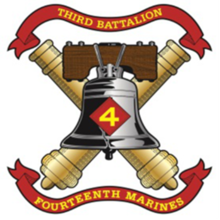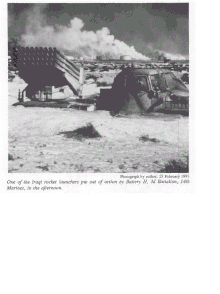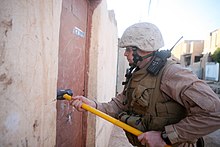3rd Battalion, 14th Marines
| 3rd Battalion, 14th Marine Regiment | |
|---|---|
 3rd Battalion, 14th Marine Regiment insignia | |
| Active | July 22, 1942 – present |
| Country | |
| Branch | |
| Type | Artillery |
| Role | Provide fire support for 4th Marine Division |
| Part of | 14th Marine Regiment 4th Marine Division |
| Garrison/HQ | Bristol, Pennsylvania |
| Engagements | World War II Iraq War |
| Commanders | |
| Current commander | LtCol Kyle D. Lynch |
| Notable commanders | Carl A. Youngdale Paul W. Brier |
3rd Battalion, 14th Marine Regiment (3/14) is a reserve artillery battalion comprising four firing batteries and a headquarters battery. The battalion is based in Bristol, Pennsylvania and its primary weapon system is the M777 howitzer with a maximum effective range of 30 km. They fall under the command of the 14th Marine Regiment and the 4th Marine Division.
Current units
| Name | Location |
|---|---|
| Headquarters Battery[1] | Bristol, Pennsylvania |
| Battery G (Golf Battery) | Fort Dix, New Jersey |
| Battery H (Hotel Battery) | Richmond, Virginia |
| Battery I (India Battery) | Allentown, Pennsylvania |
| Battery M (Mike Battery) | Chattanooga, Tennessee |
History
Second World War
Third Battalion, 14th Marine Regiment, 4th Marine Division was activated on 22 July 1942 as 3d Battalion, 12th Marine Regiment, 3d Marine Division. It was re-designated 3d Battalion, 14th Marine Regiment, 4th Marine Division on 20 February 1943. This makes it the first battalion in the 14th Marine Regiment to be activated for service in the Pacific War. The battalion initially trained at Camp Lejeune, North Carolina. From September 1943 to January 1944, the entire 14th Marine Regiment conducted training at Camp Pendleton, Camp Dunlap, Aliso Canyon, and San Clemente in California. Lieutenant Colonel Robert E. MacFarlane was appointed commanding officer, and he would remain in that role for the duration of most combat operations during World War II[2]
On 6 January 1944, 3d Battalion embarked ships for deployment in the Operation Flintlock, the U.S. campaign to take the Marshall Islands. On the morning of 31 January, elements of 1st Battalion, 25th Marines cleared the islet of Ennuebing, southwest of Roi-Namur in the Kwajalein Atoll.[3] Then, 3d Battalion landed on Ennuebing with the mission of supporting the landing on Roi-Namur. During the landing, two 75mm howitzers were lost and four marines died after two LVTs (Landing Vehicles, Tracked) sank; 3d Battalion surgeon Lieutenant Irad B. Hardy, Jr., USN, received the Navy and Marine Corps Medal for repeatedly swimming out to the floundering LVTs in order to assist marines and sailors. Third Battalion began firing on enemy Japanese positions on Roi (the western half of the Roi-Namur island) at 6:58 am on 1 February in support of 2d Battalion, 23d Marines. Roi was quickly taken by 23d Marines. The successful assault was largely due to supporting arms, including artillery from 3/14; after the battle it was estimated that supporting arms produced 60% of Japanese KIAs on Roi. Third Battalion embarked upon the USS La Salle, USS Sheridan, and USS Calvert, departing from the Kwajalein Atoll on 5 February and arriving at Maui, Territory of Hawaii on 16 February. While at Maui, 3d Battalion rested and refitted, received replacements, conducted training, and rearmed with M2A1 (M101A1) 105mm cannons.[4]
On 12 May 1944, all of 14th Marines, including 3d Battalion, embarked on board USS Leonard Wood and stopped at Pearl Harbor before setting sail towards Saipan in the Northern Mariana Islands in order to participate in Operation Forager. On 15 June, infantry units of the 4th Marine Division began landing on the southwestern coast of Saipan. As the assault on the beaches stalled, 14th Marines was ordered at approximately 1:15 pm to land. Third Battalion loaded onto DUKWs and was the first artillery unit to arrive on the shore. By 2:45 pm, 3d Battalion had pushed 50 yards inland of Yellow Beach 2 and began firing in support of the 25th Marine Regiment. At approximately 3:30 am on 16 June, 3d Battalion was critical in stopping Japanese counterattack against Company C, 1st Battalion, 25th Marines. The 4th Marine Division then made a drive towards Mt. Tapochau and Magicienne (now Laolao) Bay; all 14th Marines artillery was directed to support these assaults. The island was declared secure and the battle over on 9 July.[5]
Tinian, a little more than three miles south of Saipan, was the next objective for U.S. forces. During the beginning phases of battle, 3d Battalion was positioned on the southwestern corner of Saipan, where it provided supporting fires to the 4th Marine Division as it landed on the northwestern corner of Tinian on J-Day, 24 July 1944. On the afternoon of 26 July, 3d Battalion became the first artillery unit with guns larger than 75mm to land on Tinian; 3d Battalion was given a general support role for 4th Marine Division. The island was declared secure on 1 August, but on 4 August, Battery I of 3d Battalion repulsed a Japanese attack, marking the last combat action of the Mariana Islands campaign for 14th Marines. Third Battalion boarded SS Jean Lafitte from 5–14 August and arrived at Kahului on the island of Maui sometime between 24 and 31 August. For its actions during the Battles of Saipan and Tinian, 3d Battalion received a Presidential Unit Citation.[6]
Gulf War: Operation Desert Shield and Operation Desert Storm
In November 1990, Battery H, commanded by Capt. Paul W. Brier, and Battery I were two of four reserve artillery batteries mobilized to augment active component formations during the Gulf War. They deployed to Camp Lejeune, North Carolina, in December, and subsequently deployed to Saudi Arabia in January 1991. Battery H was attached to 1st Battalion, 11th Marines, 1st Marine Division, and Battery I to 10th Marine, 2d Marine Division, becoming parts of Task Force Papa Bear and Task Force Ripper, respectively, for the ground assault on 24 February through two obstacle belts and subsequent operations to liberate Kuwait from Iraqi forces. These active component augmentations were necessary as both of these artillery regiments were lacking one of their organic direct support artillery batteries, as they each had a battery attached to embarked and deployed Marine Expeditionary Units.
On 25 February, Battery H engaged, with direct howitzer fire, and destroyed an Iraqi mobility rocket launching system at a range of 800m, which was subsequently found to be in the center of an Iraqi brigade of D20 152mm howitzers. Battery H had just occupied an exposed firing position, having received multiple shelling which significantly wounded one cannoneer, Sgt. Chris LaCivita. The 8-gun battery's 1000m by 700m position was on the far side of the second obstacle belt, well in front of the tank and infantry maneuver units it supported, with the burning Burqan oil field to its immediate east. This positioning far forward of the forward line of troops was selected to support the 1st Marine Division's northward momentum and Task Force Papa Bear's continued and rapid assault into Kuwait City.[7]
The battery was laid on an azimuth of fire to the north, when it received a battalion mass fire mission on a target 30 km to its south.[8] Unknown the battery's Marines, an Iraqi Brigade was launching a counterattack through the burning oil field on 1st Marine Division Command Post. On battery's east flank piece (Gun #1) Gunner Sgt Shawn Toney and Section Chief Sergeant Thomas Stark, IV, spotted two enemy multiple rocket launchers as they were shifted trails to fire to the south. They engaged and destroyed launchers with heavy automatic weapons and direct fire from their M198 155mm howitzer, while the rest of the battery continued to support the fire mission to the south and defend the battery position from ground assault.[9]

LtCol. Jay Sollis, 1/11 Commander, arrived in the battery position, requested air support and directed a section of AH-1W Sea Cobra to engage the Iraqi counterattack force in the oil field.[7]
On the night of 25 February, the Battalion CP occupied a new position in support of Task Force Papa Bear. A security patrol, which included Lance Corporal Troy L. Gregory of Battery H, was organized to investigate an enemy bunker adjacent to the new CP position. While conducting this patrol, Gregory stepped on an Iraqi land mine and was critically wounded. Despite quick evacuation to a Naval Hospital, he died the following day of his wounded, just a few days before his 21st birthday. He was posthumously awarded the Purple Heart Medal and Combat Action Ribbon and was laid to rest at Arlington National Cemetery in section 60, Grave 7723. The Navy-Marine Corps Reserve Center in Richmond was renamed in his honor.[10][11]
Battery H's final position was just south of the Kuwait International Airport when the ceasefire was announced. The Battery subsequently retrograded to the 1st Marine Division Support Area in Saudi Arabia. In April, the battery redeployed to the United States and was released from active duty.
Iraq War

In 2004, Mike Battery, out of Chattanooga, Tennessee deployed to Fallujah, Iraq and took part in Operation Phantom Fury to re-take the insurgent-held city.
They later deployed again in 2007 in support of Operation Iraqi Freedom. During this second deployment, they were attached to 2nd Light Armored Reconnaissance Battalion, Regimental Combat Team 5 and operated in the vicinity of Ar Rutbah under the callsign, "Excalibur" Palehorse. The same callsign that Mike Battery used when it was a part of 4th Battalion 14th Marines during the battle of Fallujah in 2004.[12] In 2007, the unit suffered one casualty Cpl Dustin J. Lee.
2015 Chattanooga shootings
On July 16, 2015, four Marines with Mike Battery's Inspector-Instructor staff were killed by a gunman who was targeting military installations. In addition, a sailor died from his wounds two days later.
Some of the 3/14 Marines killed in action were reportedly killed while returning fire at the gunman, providing cover for a larger group of potential victims who were escaping over a fence. They were identified as:[13][14][15][16][17]
| Name | Age | Hometown | Branch | Rank |
|---|---|---|---|---|
| Carson A. Holmquist | 25 | Grantsburg, Wisconsin | Marine Corps | Sergeant |
| Thomas J. Sullivan | 40 | Springfield, Massachusetts | Marine Corps | Gunnery Sergeant |
| Squire K. "Skip" Wells | 21 | Marietta, Georgia | Marine Corps | Lance Corporal |
| David A. Wyatt | 37 | Russellville, Arkansas | Marine Corps | Staff Sergeant |
In addition, Sergeant DeMonte Cheeley,[18] was shot in the leg.[19][20]
The Battery Commander during the shootings, Major Mike Abrams, declared during the memorial service that his Marines "were selfless in their efforts to take care of one another, and they acted with unquestionable courage."[21]
MajGen Paul W. Brier, Commanding General of the 4th Marine Division, spoke at the nationally televised press conference held in Chattanooga on 22 July 2015. He praised the Marines and Sailors who risked their lives to help others and stop the gunman. “The legacy that day is one of valor.” [22] "'I can tell you that our Marines reacted the way you would expect,' the major general said. 'Rapidly going from room to room, they got their fellow Marines to safety. Once they had gotten to safety, some willingly ran back into the fight.'"[23][24][25]
See also
Notes
- ^ *U.S. Marine Corps (1999-02-01). "HEADQUARTERS BATTERY, ARTILLERY BATTALION, ARTILLERY REGIMENT, MARINE DIVISION -- TABLE OF ORGANIZATION". GlobalSecurity.Org. Retrieved 2016-03-21.
- ^ LtCol. R.J. Brown, "A Brief History Of The 14th Marines," History and Museums Division, Headquarters, U.S. Marine Corps (1990): 4-8.
- ^ H.I. Shaw, Jr., B.C. Nalty, and E.T. Turnbladh, "Central Pacific Drive: History Of U.S. Marine Corps Operations In World War II," Vol. III (1966): 145-147.
- ^ Brown: 12-22
- ^ Brown: 23-35.
- ^ Brown: 36-45.
- ^ Cureton, Col. Charles H. "With the 1st Marine Division in Desert Shield and Desert Storm" (PDF). History and Museums Division, Headquarters, U.S. Marne Corps, Washington, D.C. (1993). p. 98. Retrieved 14 May 2020.
- ^ Moore, Molly (March 17, 1991). "Faces of War". The Washington Post. Retrieved May 27, 2020.
- ^ Cureton, Col. Charles H. "With the 1st Marine Division in Desert Shield and Desert Storm" (PDF). History and Museums Division, Headquarters, U.S. Marne Corps, Washington, D.C. (1993). p. 98. Retrieved 14 May 2020.
- ^ "LCpl. Troy L. Gregory". Arlington National Cemetery, Washington, D.C. (1991). Retrieved 14 May 2020.
- ^ "Virginia Heroes: Troy Lorenzo Gregory, Lance Corporal, USMC". Virginia War Memorial Foundation (1991). Retrieved 14 May 2020.
- ^ Tomlinson, Ryan (20 June 2008). "'Excalibur' owns the night". marines.mil. Retrieved 13 October 2015.
- ^ McClam, Erin (July 22, 2015). "Chattanooga Shooting: Service Member Opened Fire on Gunman Mohammad Abdulazeez". NBC News. Retrieved July 22, 2015.
- ^ Kunzelman, Michael; Foody, Kathleen (July 17, 2015). "How did gunman go from ordinary suburban kid to killer?". Yahoo! News. Retrieved July 17, 2015.
- ^ "Chattanooga Shooting Suspect's Trip to Jordan Scrutinized by Authorities". The Wall Street Journal. July 17, 2015. Retrieved July 17, 2015.
- ^ "Tennessee gunman had unremarkable past; his 5th victim dies". MSN. July 18, 2015. Retrieved July 18, 2015.
- ^ Fausset, Richard; Pérez-Peña, Richard; Apuzzo, Matt (July 22, 2015). "Service Members Risked Lives During Chattanooga Attack, Officials Say". The New York Times. Retrieved July 22, 2015.
- ^ "Four misconceptions about the Chattanooga shooting". Chattanooga Times Free Press. July 24, 2015. Retrieved July 24, 2015.
- ^ "Four Marines Killed in Chattanooga Shootings". The New York Times. July 16, 2015. Retrieved July 16, 2015.
- ^ Dickson, Caitlin (July 17, 2015). "Chattanooga shooting victims: IDs of 4 Marines become known". Yahoo! News. Retrieved July 17, 2015.
- ^ Brady, Terry (August 15, 2015). "Families, Friends Pay Last Respects to Chattanooga Victims". marines.mil. Retrieved October 13, 2015.
- ^ Goldman, Adam (22 July 2015). "Chattanooga shooter methodically moved through naval reserve center". washingtonpost.com. Retrieved 15 May 2020.
- ^ Botelho, Greg (15 September 2015). "Chattanooga shootings: Gunman shot at after he rams gates, then kills 5". cnn.com. Retrieved 15 May 2020.
- ^ "Four Marines Killed in Chattanooga Shootings". The New York Times. July 16, 2015. Retrieved July 16, 2015.
- ^ Fausset, Richard; Pérez-Peña, Richard; Apuzzo, Matt (July 22, 2015). "Slain Troops in Chattanooga Saved Lives Before Giving Their Own". The New York Times (nytimes.com). Retrieved May 22, 2020.
References
 This article incorporates public domain material from websites or documents of the United States Marine Corps.
This article incorporates public domain material from websites or documents of the United States Marine Corps.
- Web


